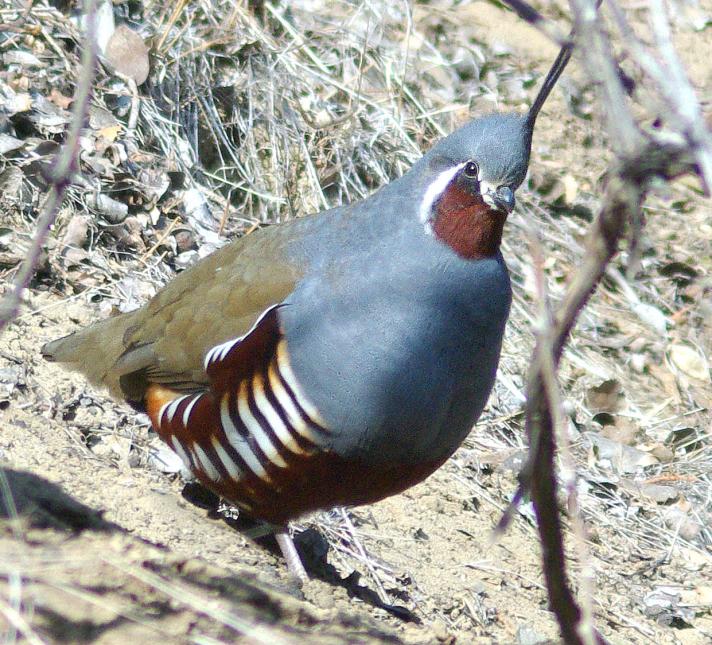Mountain quail populations have declined to very low levels within their native range in eastern Washington and were (or continue to be) absent in some areas. They are at the edge of their range in Washington. Eastern Washington populations are thought to have declined due to loss or degradation of dense shrub communities resulting from intensive cattle grazing practices and hydroelectric and other development in riparian zones.
Mountain quail are managed as upland game birds. For current rules about hunting mountain quail in the state, be sure to check the Washington Game Bird and Small Game hunting regulations.
Description and Range
Physical description
The mountain quail is about 11 inches in length. Two long, thin black plumes adorn the head. This bird is gray to brownish above and it has a gray breast. Its sides are rust-colored with white barring. Its throat is rust-colored, outlined with a vertical white stripe on both sides.
Ecology and life history
This species requires dense shrub cover, brushy, riparian habitat in dry areas, and brushy slopes. They are found in dense cover with scattered open areas on slopes in foothills and mountains. They use dense thickets resulting from fires or clear cuts, and they are seldom found far from this cover. In summer, the quail require a source of water, which may limit their nesting range.
Diet varies with the season but consists primarily of seeds, bulbs, leaves, berries, and some insects. One of the most important foods is sumac. Insect and other animal matter are a minor source of food, comprising less than five percent of the diet overall.
Mountain quail nest on the ground in dense cover, usually sheltered by a shrub, log, or clump of grass. Like other quail, their nests are shallow depressions lined with grass, needles, leaves, and feathers. Females lay nine to 10 eggs, which both parents incubate. Shortly after hatching, the young leave the nest. Both parents incubate their own nest and then tend and actively defend the young and lead them to food sources, where they feed themselves.
Geographic range
Although the species has been introduced to parts of western Washington, where it is somewhat common, Asotin, Garfield, and Columbia counties are the mountain quail’s native range. The species was once abundant in Klickitat County and may have been native there historically.
After being extirpated from portions of the historical distribution, 309 mountain quail were released in the Asotin Creek watershed between 2005 and 2013. Survival of released birds to six months of age post-release has ranged between 18 to 34 percent. It is not clear whether these attempts have established populations that will become self-sustaining. While incidental observations of mountain quail continue to occur in the area, deriving a population estimate for this small, widely dispersed population in remote habitat is not currently practical.
For maps of worldwide distribution and other species' information, check out NatureServe Explorer and the International Union for Conservation of Nature - Red List.
Climate vulnerability
Sensitivity to climate change
Moderate
Mountain quail inhabit dry areas and are dependent upon surface and preformed water availability. They exhibit sensitivity to increased temperatures or changes in precipitation that limit water supply. Increased fire severity and frequency that results in the conversion of suitable habitat also increases the overall sensitivity of this species.
Exposure to climate change
Moderate
- Increased temperatures
- Changes in precipitation
- Altered fire regimes
Regulations
Rules and seasons
Mountain quail are managed as upland game birds. For current rules about hunting mountain quail in the state, be sure to check the Washington Game Bird and Small Game hunting regulations. For additional information about hunting opportunities and strategies, check out WDFW's Upland bird hunting and Quail Hunting pages.
Conservation
Mountain quail is designated by WDFW as a “Species of Greatest Conservation Need” in Eastern Washington only.
Conservation Threats and Actions Needed
- Energy development and distribution
- Threat: Hydroelectric development along the Snake River has resulted in the loss of key riparian habitat.
- Action: Protect as-yet undeveloped habitat along tributaries.
- Agriculture and aquaculture side effects
- Threat: Mountain quail require dense shrub cover and brushy areas. Use of herbicide kills shrubs and plants required for cover and forage, particularly sumac.
- Action: Work with landowners to use best management practices.
- Threat: Mountain quail require dense shrub cover and brushy areas. Intensive grazing practices have damaged habitat required for cover and forage.
- Action: Protect as-yet undeveloped habitat along tributaries.
- Resource information collection needs
- Threat: Success of translocation efforts is not clear and trend data are lacking.
- Action: Evaluate results from translocations to assess effectiveness of release strategies.
See the Climate vulnerability section for information about the threats posed by climate change to this species.
Resources
References
WDFW. 2015. Game Management Plan July 2015 - June 2021. Washington Department of Fish and Wildlife, Olympia, Washington.
WDFW. 2014. 2014 Game status and trend report. Washington Department of Fish and Wildlife, Olympia, Washington.
